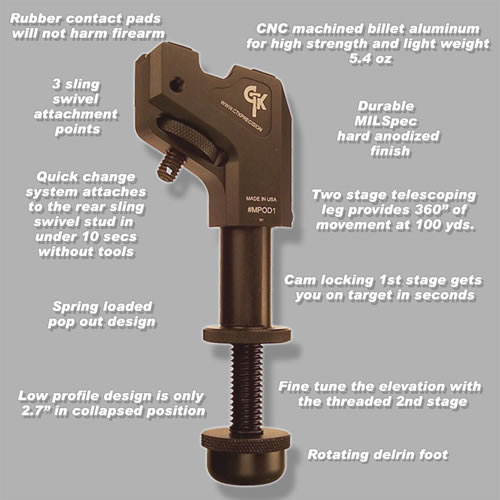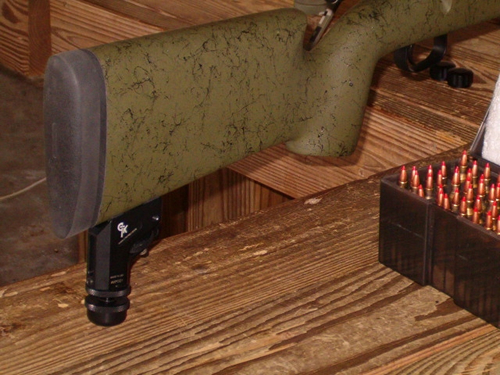CTK Precision P3 Monopod
Review by Rob Martin
Every once in a while, a new product comes along that deserves a good looking at. The P-3 monopod from CTK Precision is just such a product. Most of us rely on a good front rest and rear bag combination to achieve accuracy from the bench, or a bipod and beanie baby rear bag for the field. So what about the times that a rear bag is not practical, or might be a tad heavy to carry? In the case of my wife, rear bags are not only uncomfortable, but very awkward to use. Personally, I’m a bag squeezer from way back, using my off hand to fine tune the elevation of my shot. My wife, on the other hand, usually chucks the rear bag in favor of a clenched fist to rest the butt stock on. While her shooting can be very good, using the clenched fist method is not very conducive to repeatability.
We decided to test the P-3 monopod on my wife’s new Stevens 200 built for mid to long range varmint and target shooting. Under normal circumstances, this rifle wears a Harris bench rest bipod. She prefers using a clenched fist in place of a rear bag while shooting, a situation we are hoping to correct with the P-3 monopod. Let’s take a look at the product itself, so we can show you some of its unique features, making it the best in its class that I have tested. First and most obviously, is the fact that this is it not a folding model, rather a fixed, quick detach model more conducive to a solid rear rest. I have owned several rear monopods in the past, but every one of them has been a folding model of some type. The problem with this type of monopod is that it always folds at the most inopportune moments (usually while lining up a shot) resulting in a botched shot, pinched skin in my armpit or a broken rear sling stud. This is the first model I have tested that is both fixed and fully adjustable for elevation.

As you can see, the P3 Monopod is loaded with features making it very user friendly.

Here we see the CTK Precision P3 rear monopod installed on the author’s wife’s Stevens 200 based target rifle.
Attaching the P-3 monopod to the rifle takes a little practice. It uses the rear sling stud and attaches fairly easily, but it took me a couple of tries to do it smoothly. There are three sling attachment points on the monopod itself so that when installed you don’t lose the ability to attach a sling to the rear of the rifle. Another nice feature of the monopod is the rubber pads between the aluminum of the monopod and the rifle stock, helping to protect the finish of the stock. The adjustability of the monopod is of a two-stage design, with a spring-loaded first stage to quickly bring the monopod up to shooting level, and a thumbwheel adjustment for fine tuning onto target. The first stage of adjustment requires a slight twist to unlock the shaft and lock it back in place. The fine tune adjustment simply uses a thumbwheel and threaded secondary shaft to raise and lower the rear of the rifle in small increments. During testing, I found by using the fine tuning adjustment wheel, I could move my point of impact at an eighth of an inch at that time without much thinking involved. Using a rear bag adjustments this fine usually involve just enough “pinch” to get right, and to get repeatable results, well, takes a mighty precise pinch.
To further compare the differences that I found using the rear monopod as opposed to a rear bag, I decided to set up a little test. I set up a series of targets at 100 yards. The targets were 1 inch poster dots spaced approximately 3 inches on center in a grid. I wanted to put two shots in each dot in quick succession, using either the rear bag or the monopod for elevation changes. The results were kind of a mixed bag. While I was faster with the bag, due to years of experience shooting from a front rest/rear bag position, the more precise groups were shot with the rear monopod. After a few groups I was able to quickly determine how many turns it took to raise the elevation the 3 inches required to get the next dot. I quickly had the speed worked out on the monopod to the point where it was nearly as fast as squeezing the bag to change the elevation.
The only complaint I had with the unit itself was the foot. It’s not a design fault, rather a fault of the combination of the surface from which I was shooting and the material used for the foot. The plastic used for the foot, while very durable, is also very slick on certain surfaces, namely wood and slick concrete. While shooting from prone, I had no problems with the foot slipping on dirt or my shooting mat. From the bench, however, I had problems keeping the shot lined up on the slick surface. In my shooting bag I normally keep a mouse pad to put under my elbow while shooting big bores. Flipping the mouse pad upside down and placing in under the rear monopod I found that slippage did not occur at all. A quick trip to the hardware store would easily net you a nice rubber furniture foot to place over the delrin foot to prevent slippage.
Now for the real world uses! The wife and I decided to put the P-3 Monopod through its paces in the field doing some varmint control on a local cattle farm. The farmer is having problems with feral hogs and coy-dogs (coyote/dog hybrids), and once or twice a month, we take the opportunity to do a little night varmint hunting. Being a cattle farm, there is very little cover from which to hunt, so low-crawling and prone shooting are the order of the day (or as it happens, night). Here, the P-3 really shines. Setting up with the bipod and monopod for a nice, rock steady hold made the hunt much better. For those of you who have never had the pleasure of night varmint hunting, you really have an exceedingly small amount of time to acquire the target and make the shot. Not having to worry about the rear rest makes the shot that much quicker-and speed is of the essence. Sorry, night hunting doesn’t lend itself well to photography at my level. Two hogs and three coy dogs (and don’t tell anyone, but a raccoon as well) fell to the P-3 equipped Stevens that night, me on the infrared spotlight and my wife behind the trigger.
All in all, this is a handy addition as a solid and expedient rear rest. The construction is superb and the finish very good. It will take a little practice getting the unit on and off the rifle smoothly, but at least it doesn’t require an easily lost tool. Another thing that might require a bit of practice is the adjustable first stage of elevation. On the bench with the Harris Bench Rest Bipod, the first stage was not needed at all, only a slight extension of the fine tuning second stage. It is merely a simple twist to adjust the first stage (but the unit I received for testing did not come with instructions, so it took a little head scratching (truth be told, my wife figured it out in about five seconds-sometimes I can be a bit of a moron, though!) Again, my only complaint was the slickness of the foot, but that is pretty minor and easily remedied.
Quality: *****
This is a very well made piece, excellent machining and very solid, even at full extension.
Fit & Finish: ****
The mil-spec finish is really the industry standard for gear of this sort. I hesitate to give the P-3 five stars for only one reason-the finish on the first stage tube will wear off due to the tight tolerances of the fit. With that one exception, it’s very good.
Accuracy: *****
It does it’s job, enhancing accuracy by creating a rock solid rear rest. Group sizes shrunk by about 10% for me and brought my wife to the next level insofar as repeatability goes.
Value: ***
Ouch. It’s a bit on the pricey side, but worth it if you need it (which we did).
Contact Information
CTK PRECISION
E5861 Herzberg Road
Marion, WI 54950
Phone: (715) 754-2891
www.ctkprecision.com
Original Review: Savage Shooters